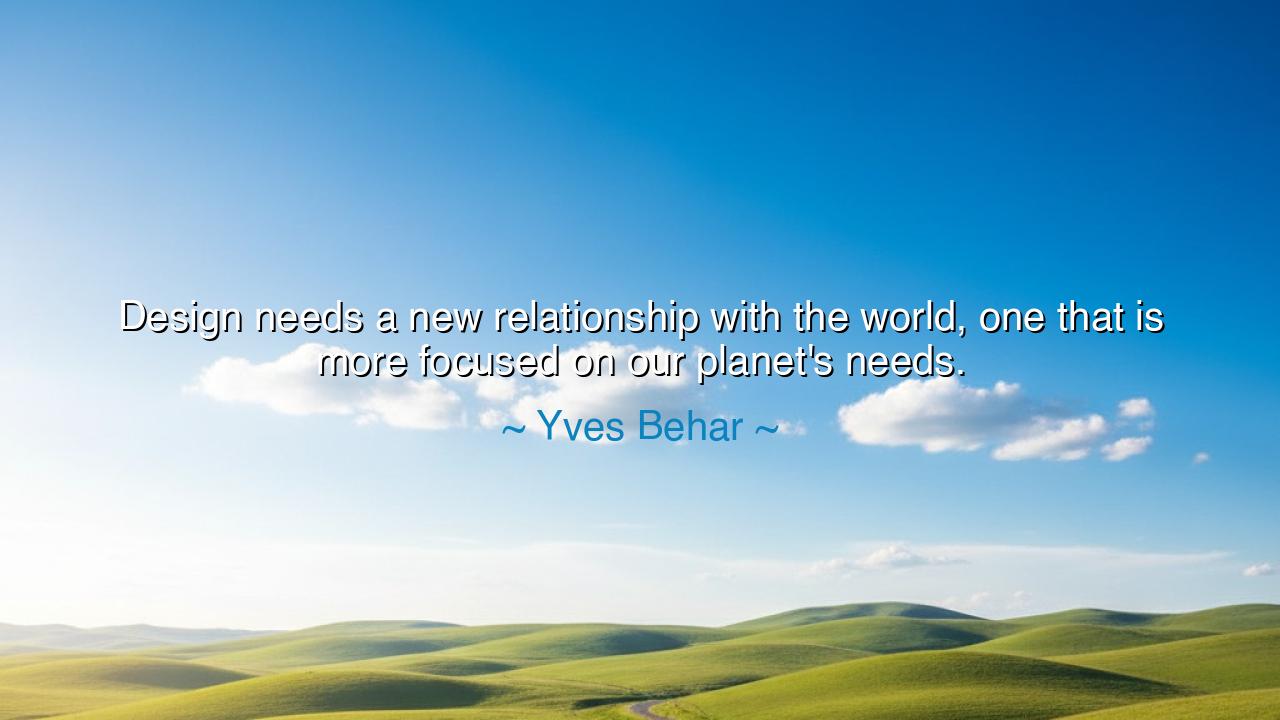
Design needs a new relationship with the world, one that is more
Design needs a new relationship with the world, one that is more focused on our planet's needs.






The visionary designer Yves Béhar once declared: “Design needs a new relationship with the world, one that is more focused on our planet’s needs.” These words are both a reflection and a warning—a call from the heart of creation itself. For Béhar, design is not merely the shaping of form or the pursuit of beauty; it is a dialogue with the Earth, a covenant between human imagination and the living world that sustains it. His quote arises from the awareness that modern design has often strayed from this sacred bond, serving consumption instead of conservation, fashion instead of future. He reminds us that the artist, the engineer, and the craftsman must once again become servants of life, not its masters.
In the ancient days, to design was an act of reverence. The builders of temples, the weavers of cloth, the makers of vessels—all shaped their creations in harmony with nature’s rhythms. The Greeks built their columns in imitation of trees, believing the laws of proportion to be divine. The Japanese masters of architecture raised homes that breathed with the wind and bowed to the seasons. These were not acts of domination but of partnership—human hands working in quiet understanding with the materials of the earth. Béhar’s words call us back to that wisdom: that design must serve the planet, not exploit it, and that beauty without balance is merely vanity.
In our time, the Earth cries out under the weight of our inventions. Forests fall for disposable packaging; oceans drown in plastic; cities sprawl like unchecked fires across once-living land. The very ingenuity that once built civilizations now threatens to unmake them. Yet Béhar sees within design the power of redemption. He envisions a new relationship, one in which creativity listens instead of conquers, one where design heals rather than harms. His message is both a plea and a prophecy—that the designers of today must become the architects of regeneration, crafting not only for human delight but for the well-being of every creature that shares this fragile world.
History offers us both warning and hope. Consider the tale of the Industrial Revolution, when invention surged like a mighty river—bringing prosperity, but also pollution and alienation. The factories of that age darkened skies and poisoned waters, and yet out of that chaos arose new voices—artists like William Morris, who led the Arts and Crafts Movement. He called for a return to craftsmanship, for work that respected both maker and material. Béhar’s words carry the same spirit, reborn in a modern tongue: that we must merge innovation with conscience, technology with tenderness, progress with preservation.
Design, at its highest calling, has always been more than appearance—it is ethics made visible. Every object we create tells a story of values. When we design wastefully, we tell a story of greed; when we design thoughtfully, we tell a story of care. Béhar challenges us to choose our story wisely. A chair, a phone, a building, or a city can be born from the same intention—to serve life, or to drain it. It is the heart of the designer that determines which it shall be. Thus, in every blueprint, there lies a moral choice: to take or to give, to harm or to heal.
The lesson, then, is this: creation carries responsibility. To design for the planet’s needs is not to abandon beauty, but to redefine it. True beauty is not the gleam of excess, but the grace of harmony—the quiet assurance that nothing has been wasted, that every curve and color honors its source. Let each of us, whether artist or consumer, begin to see design not as decoration, but as stewardship. The world does not ask us for perfection, only for care: care in what we make, what we use, and what we leave behind.
So remember, O student of the future: the Earth is not a backdrop for your creations—it is your collaborator. Listen to its needs as you shape your designs, for the clay remembers, the metal endures, and the wind whispers wisdom to those who pause to hear it. Design anew, but design with reverence. For when our hands work in harmony with the planet, every object becomes a prayer, every invention an offering. And in that sacred partnership between human and Earth, creation finds its truest, most enduring form.






AAdministratorAdministrator
Welcome, honored guests. Please leave a comment, we will respond soon